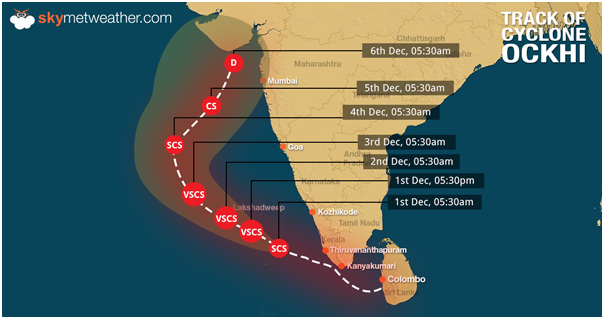What is the issue?
- Cyclone Ockhi that struck the Kanniyakumari district in Tamil Nadu and parts of Kerala has left many fishermen dead and about a thousand of them missing.
- The large-scale loss of lives and livelihood has raised serious questions about disaster management and government response.
How was the disaster response?
- There are three basic shortfalls in the government’s response:
- the cyclone warning was delayed
- the warning, when it came, was ineffective because it could not be communicated to thousands of fisherfolk who were already out at sea
- once the cyclone struck, there was no war-like mobilisation and action for rescue operation
- Moreover, the response from the Coast Guard and the Indian Navy was very poor, as per the fishermen reports.
- The seaborne vessels and helicopters and vast array of ships, aircraft and state-of-the-art technology if deployed would have prevented loss of so many lives.
- Coast Guard ships accompanied by fishermen from the villages as navigation assistants would have made easier the search process.
- This was not carried out, and even when the Coast Guard did, it only went up to about 60 nautical miles.
- It was reluctant to go beyond citing jurisdictional limitations.
- The Disaster Management legislations, policies and mechanisms largely failed in making proper response in saving the lives, thus aggravating the disaster.
Why is Kanniyakumari more vulnerable?
- Fishing - Kanniyakumari district in Tamil Nadu has one of the highest densities of fisherfolk in India.
- Given the limited quantity of fish in nearshore waters, many fisherfolk have diversified into deep-sea and long-distance fishing.
- Their fishing voyages sometimes last from ten days to more than a month.
- Thus, the Indian Meteorological Department’s timing of cyclone warning just 12 hours before it hit the coast was futile.
- Moreover, there are limitations for deep sea fishers in using satellite phones and other devices to facilitate boat-to-shore communications for security reasons.
- Geography - How early the forecast is depends on how far the coast is from the place where the cyclone is emerging.
- Many of the big cyclones like Phailin, Hudhud and Vardah developed near the Andaman Sea from where it took about five to six days to hit the coast.
- But Ockhi originated near the south-western coast of Sri Lanka, and travelled very near the southern-most tip of the Indian mainland.
- The origin of the cyclone much closer to the Kanniyakumari coast rendered the lead time for the forecast much less.

What lies ahead?
- Compensation to the victims requires the combined efforts of the Central and State governments.
- Climate change is resulting in changing weather patterns and coastal areas will need to adapt to hitherto unknown conditions, especially frequent storms.
- Disaster warning mechanism thus needs a revamp and quick-response systems should be put in place.
- The state government should certainly improve its communication systems.
- The Met department needs to become more people-friendly and learn to issue jargon-free advisories.
- Further, forming a separate Fisheries Ministry to address the issues associated with the fishermen community could prove to be a better administrative response.
Source: The Hindu
